
The Mosin–Nagant is a five-shot, bolt-action, internal magazine–fed military rifle. Known officially as the 3-line rifle M1891 and informally in Russia and the former Soviet Union as Mosin's rifle, it is primarily found chambered for its original 7.62×54mmR cartridge.

The Springfield Armory, more formally known as the United States Armory and Arsenal at Springfield located in the city of Springfield, Massachusetts, was the primary center for the manufacture of United States military firearms from 1777 until its closing in 1968. It was the first federal armory and one of the first factories in the United States dedicated to the manufacture of weapons. The site is preserved as the Springfield Armory National Historic Site, Western Massachusetts' only unit of the national park system. It features the world's largest collection of historic American firearms.
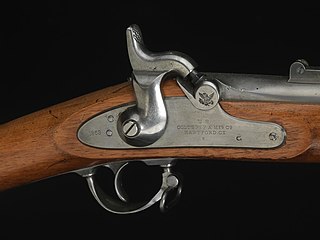
The Springfield Model 1861 was a Minié-type rifled musket used by the United States Army during the American Civil War. Commonly referred to as the "Springfield". It was the most widely used Union Army shoulder weapon during the Civil War, favored for its range, accuracy, and reliability.

The Type 38 rifle is a bolt-action service rifle that was used by the Empire of Japan predominantly during the Second Sino-Japanese War and Second World War. The design was adopted by the Imperial Japanese Army in 1905. Due to a lack of power in its 6.5×50mmSR Arisaka cartridge, it was partially replaced during the war with the Type 99 rifle, but both rifles saw usage until the end of the war.
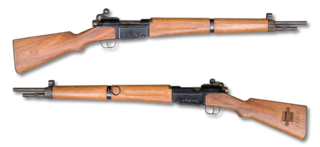
The MAS Modèle 36 is a military bolt-action rifle. First adopted in 1936 by France and intended to replace the Berthier and Lebel series of service rifles, it saw service long past the World War II period. It was manufactured from late 1937 onward by Manufacture d'Armes de Saint-Étienne (MAS), one of several government-owned arms factories in France. Only 250,000 MAS-36 rifles were available to equip the French infantry during the Battle of France in 1940. Mass production finally caught up after World War II and MAS-36 rifles became widely used in service during the First Indochina War, the Algerian War, and the Suez Crisis. Altogether, about 1.1 million MAS-36 rifles had been manufactured when production ceased in 1952.
The Henry repeating rifle is a lever-action tubular magazine rifle famed both for its use at the Battle of the Little Bighorn and being the basis for the iconic Winchester rifle of the American Wild West.

The M1819 Hall rifle was a single-shot breech-loading rifle designed by John Hancock Hall, patented on May 21, 1811, and adopted by the U.S. Army in 1819. It was preceded by the Harpers Ferry M1803. It used a pivoting chamber breech design and was made with either flintlock or percussion cap ignition systems. The years of production were from the 1820s to the 1840s at the Harpers Ferry Arsenal. This was the first breech-loading rifle to be adopted in large numbers by any nation's army, but not the first breech-loading military rifle – the Ferguson rifle was used briefly by the British Army in the American Revolutionary War. The Hall rifle remained overshadowed by common muskets and muzzleloading rifles which were still prevalent until the Civil War. The early flintlocks were mostly converted to percussion ignition.

Hanyang Arsenal was one of the largest and oldest modern arsenals in Chinese history.
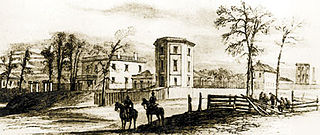
The Fayetteville Arsenal in Fayetteville, North Carolina was built in 1838 because during the War of 1812 the United States government realized that the existing distribution of weapons and ammunition factories was not adequate for the defense of the country. A program was begun to provide more Federal arsenals which would be distributed so that no area of the country would be too far away from an arms depot. Bladen County Representative James McKay introduced House Resolution #374 for inclusion of an arsenal at Fayetteville.
The Springfield Model 1812 Musket is a .69 caliber, flintlock musket manufactured by the Springfield Armory.
The M1941 Johnson Rifle is an American short-recoil operated semi-automatic rifle designed by Melvin Johnson prior to World War II. Although the M1941 was used in limited numbers by the US Marines during the Second World War, it unsuccessfully competed with the contemporary M1 Garand rifle.
The M1841 Mississippi rifle is a muzzle-loading percussion rifle used in the Mexican–American War and the American Civil War.

The Richmond rifle was a rifled musket produced by the Richmond Armory in Richmond, Virginia, for use by the Confederate States Army during the American Civil War.
During the American Civil War, an assortment of small arms found their way onto the battlefield. Though the muzzleloader percussion cap rifled musket was the most numerous weapon, being standard issue for the Union and Confederate armies, many other firearms, ranging from the single-shot breech-loading Sharps and Burnside rifles to the Spencer and the Henry rifles - two of the world's first repeating rifles - were issued by the hundreds of thousands, mostly by the Union. The Civil War brought many advances in firearms technology, most notably the widespread use of rifled barrels.
The Lorenz rifle was an Austrian rifle used in the mid 19th century. It was used in the Second Italian War of Independence in 1859 and the Austro-Prussian War in 1866, and also featured prominently in the American Civil War.
The term Joslyn Rifle refers to a series of rifles produced in the mid-19th century. The term is often used to refer specifically to the Joslyn Model 1861/1862, which was the first mass-produced breech-loading rifle produced at the Springfield Armory.
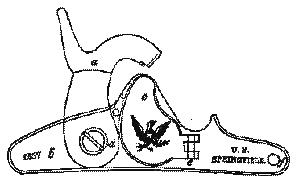
The Springfield Model 1855 was a rifled musket widely used in the American Civil War. It exploited the advantages of the new conical Minié ball, which could be deadly at over 1,000 yards (910 m). It was a standard infantry weapon for Union and Confederates alike, until the Springfield Model 1861 supplanted it, obviating the use of the insufficiently weather resistant Maynard tape primer.
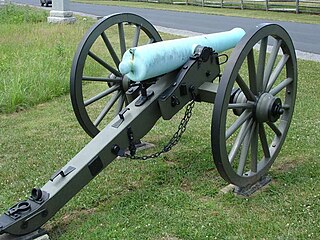
The M1857 12-pounder Napoleon or Light 12-pounder gun or 12-pounder gun-howitzer was a bronze smoothbore muzzleloading artillery piece that was adopted by the United States Army in 1857 and extensively employed in the American Civil War. The gun was the American-manufactured version of the French canon obusier de 12 which combined the functions of both field gun and howitzer. The weapon proved to be simple to produce, reliable, and robust. It fired a 12.03 lb (5.5 kg) round shot a distance of 1,619 to 1,680 yd at 5° elevation. It could also fire canister shot, common shell, and spherical case shot. The 12-pounder Napoleon outclassed and soon replaced the M1841 6-pounder field gun and the M1841 12-pounder howitzer in the U.S. Army, while replacement of these older weapons was slower in the Confederate States Army. A total of 1,157 were produced for the U.S. Army, all but a few in the period 1861–1863. The Confederate States of America utilized captured U.S. 12-pounder Napoleons and also manufactured about 500 during the war. The weapon was named after Napoleon III of France who helped develop the weapon.

The 38th New York Infantry Regiment was a two-year infantry regiment in the U.S. Army during the American Civil War.











